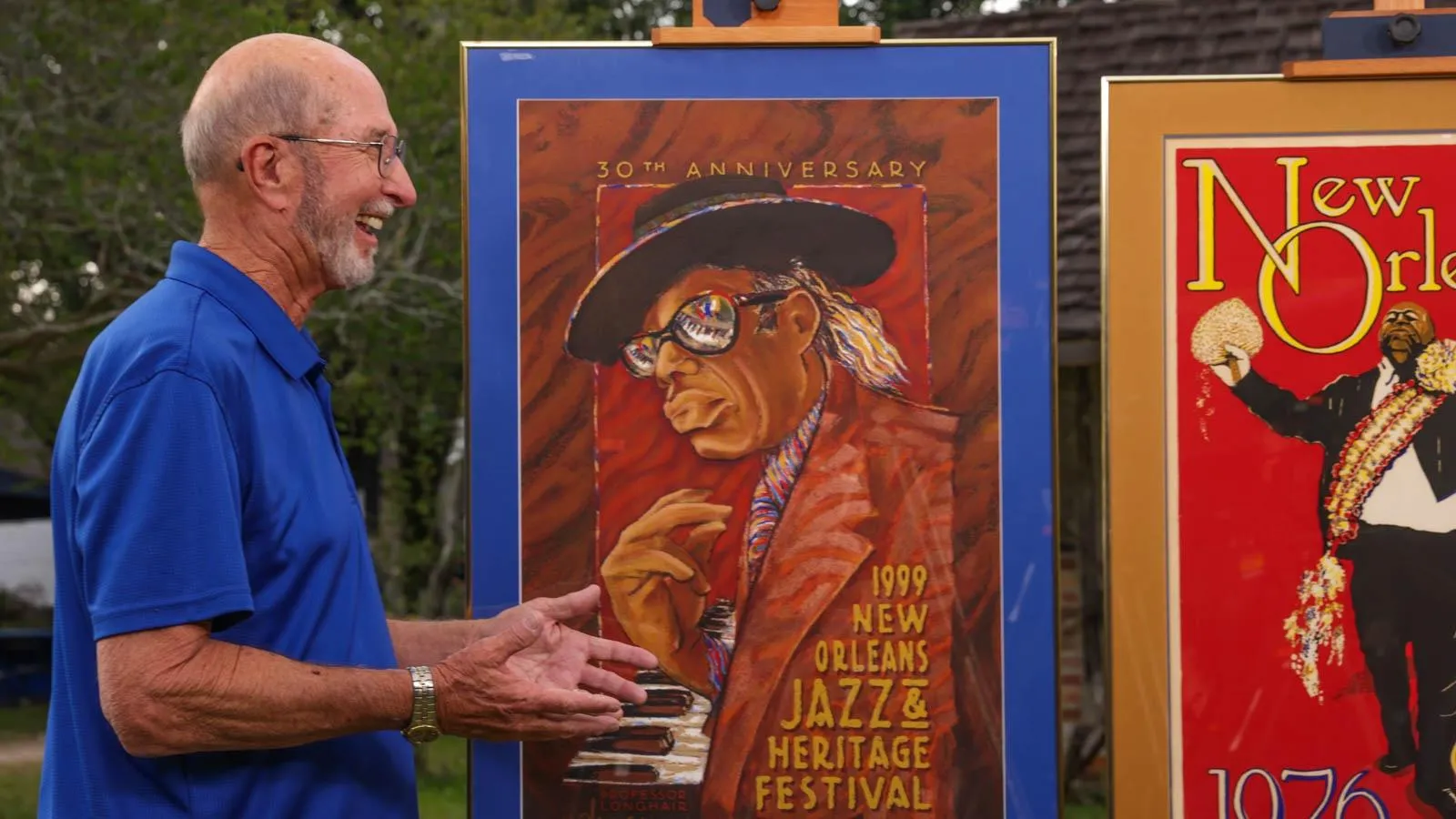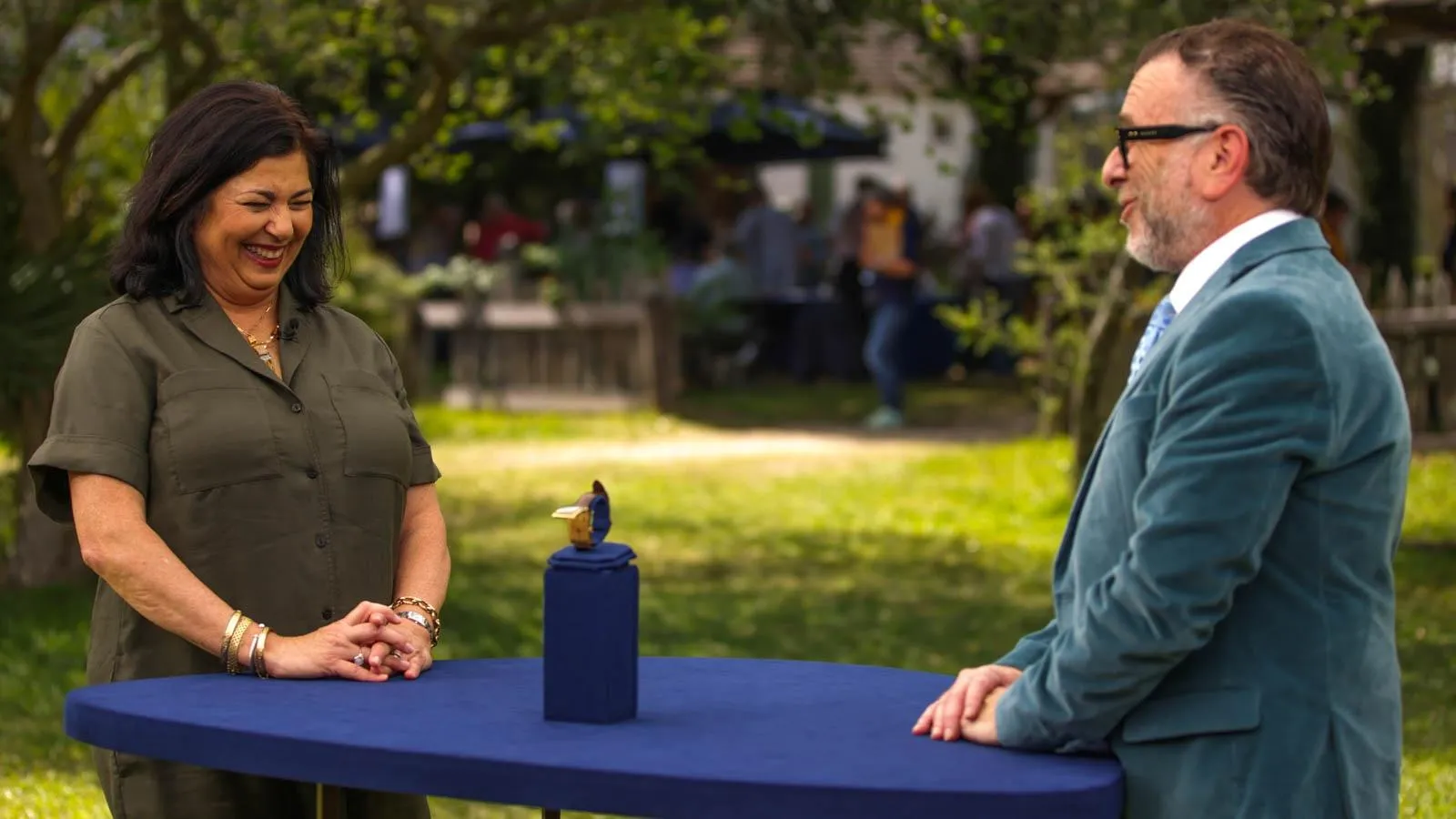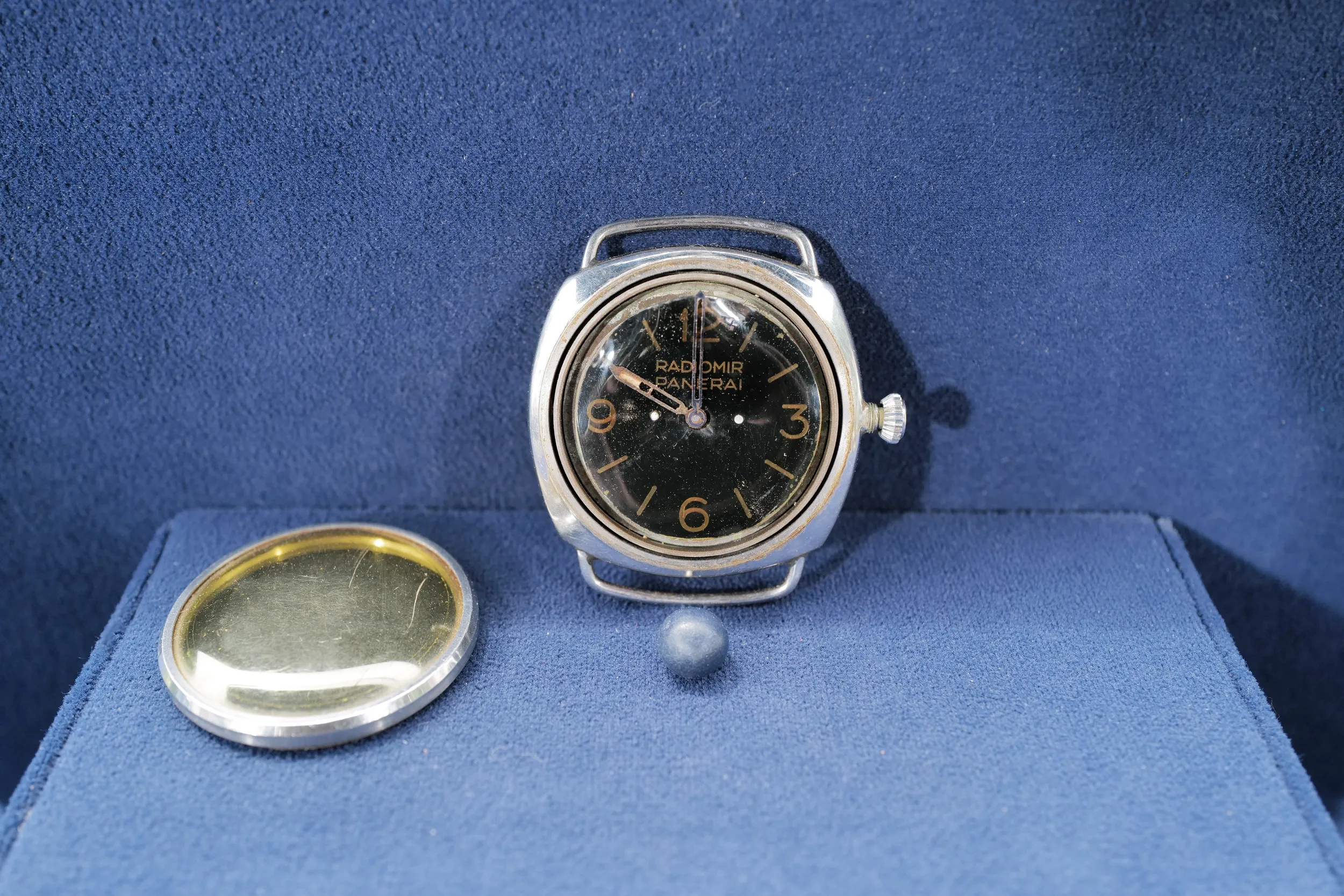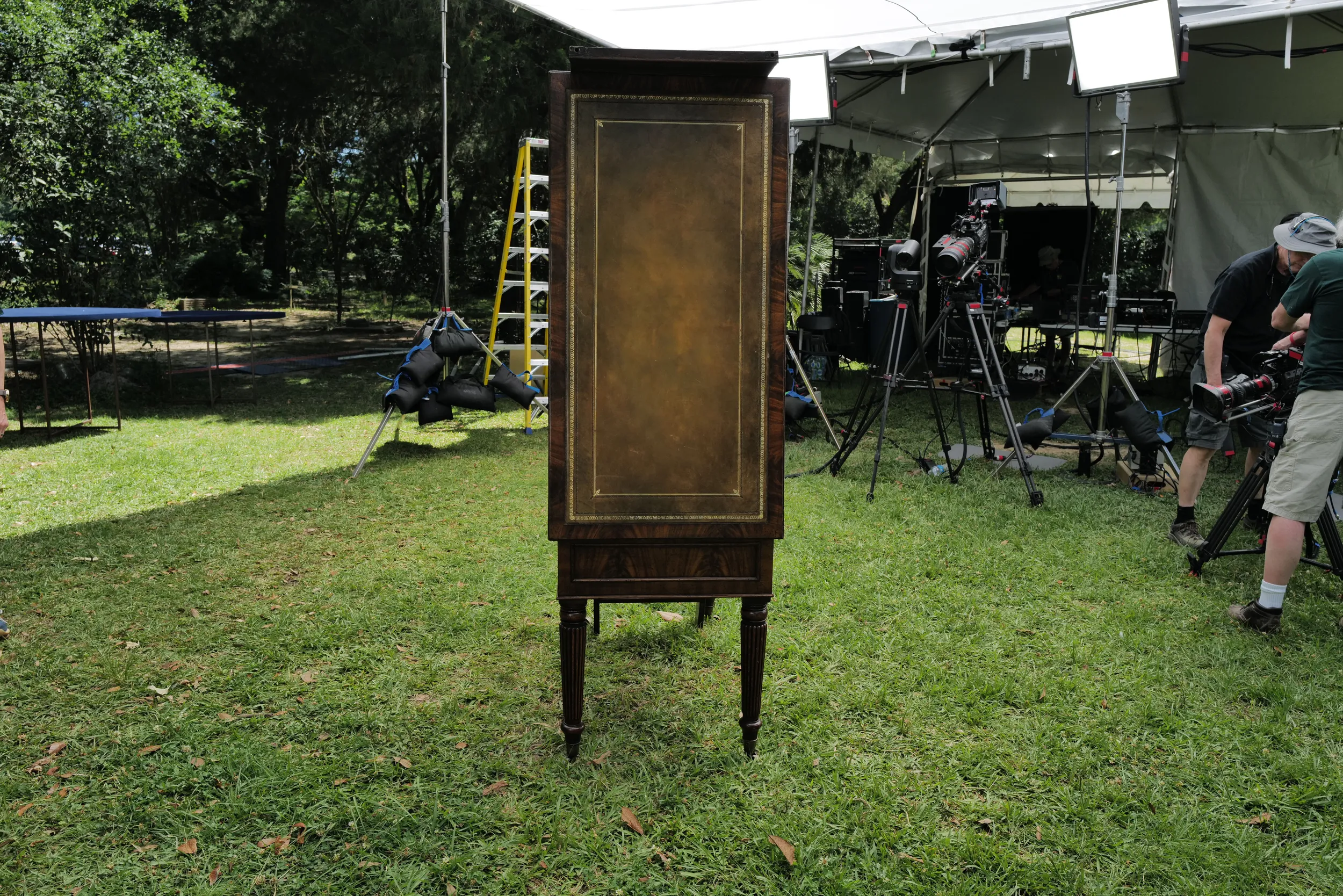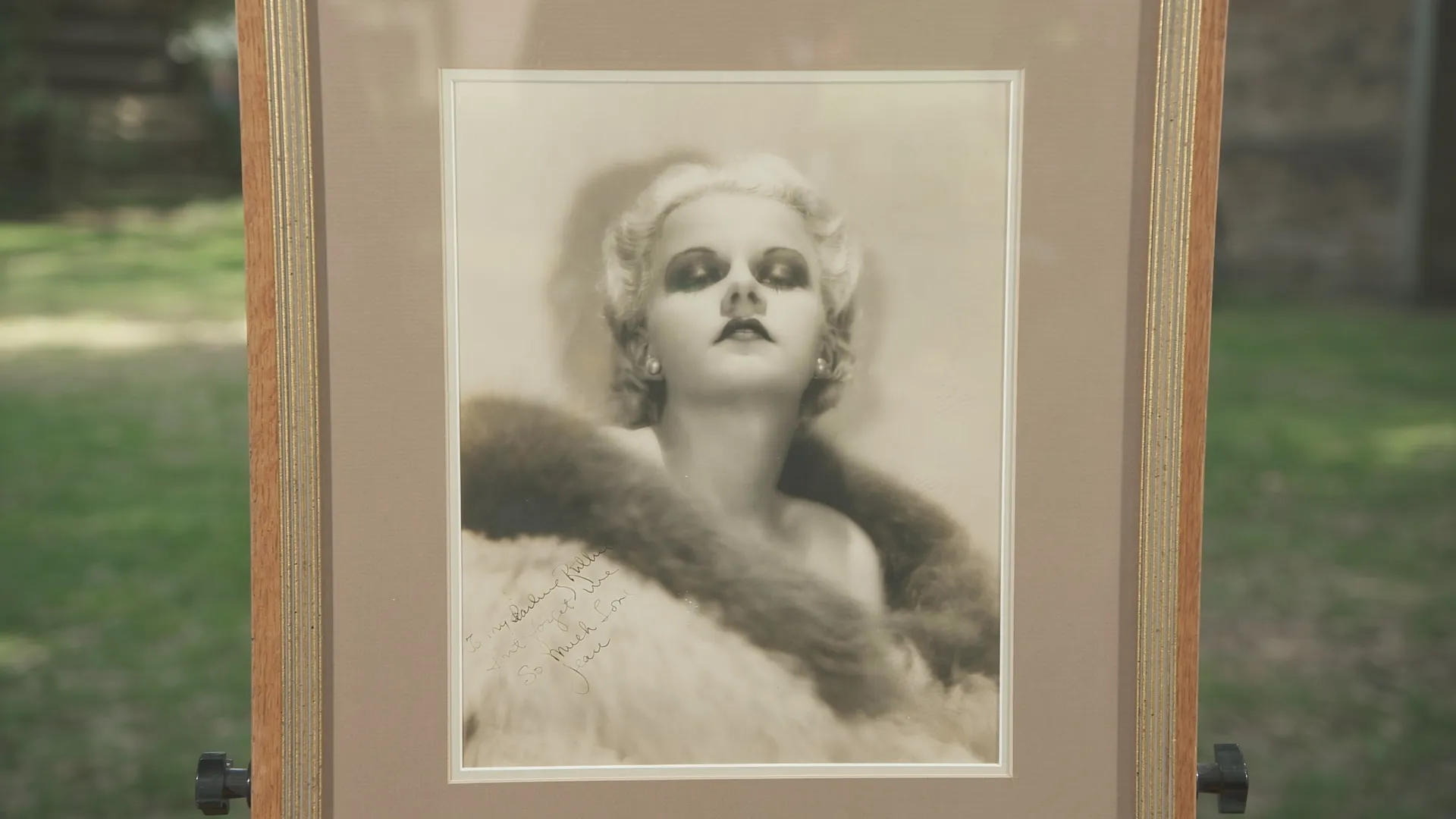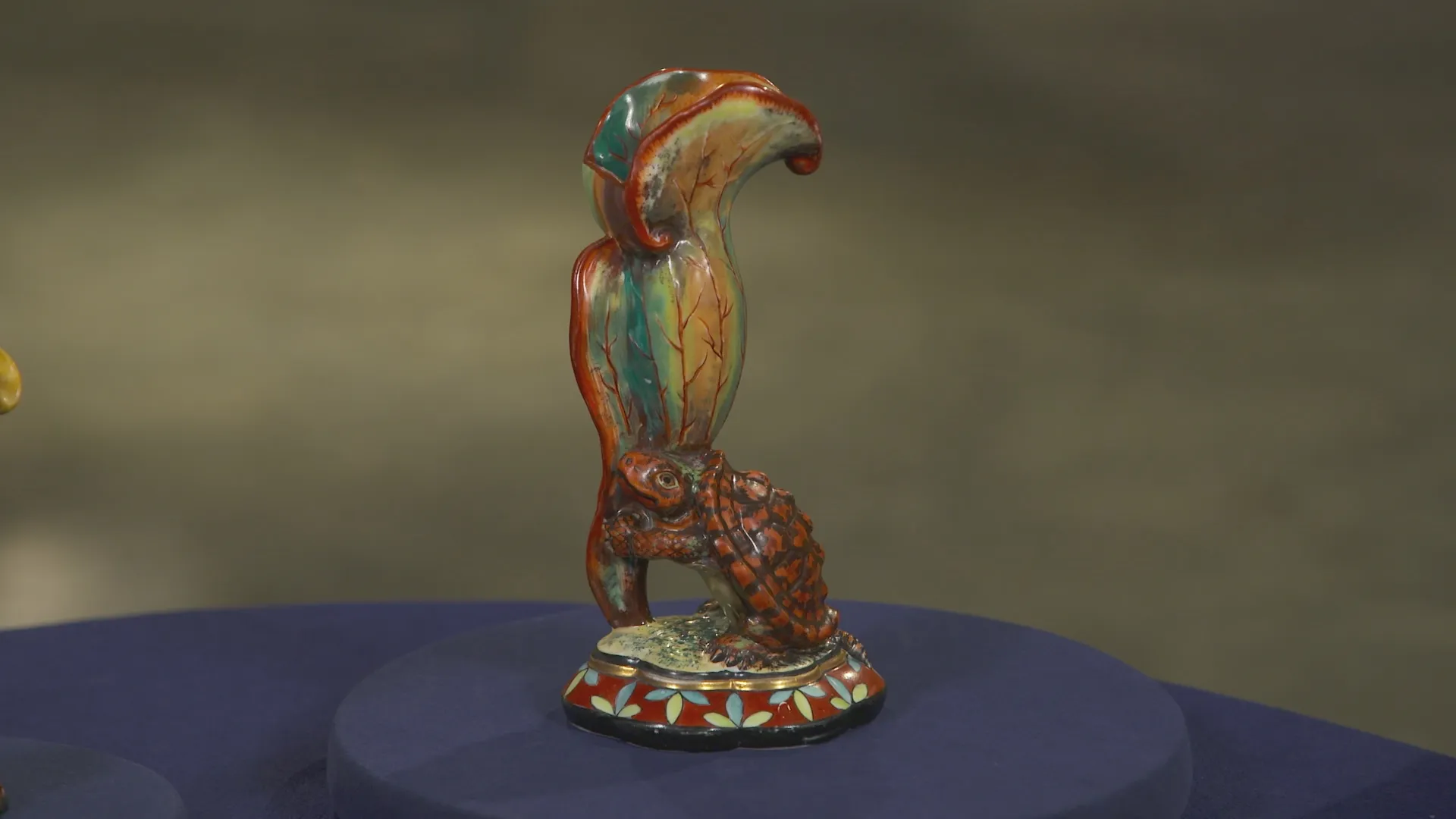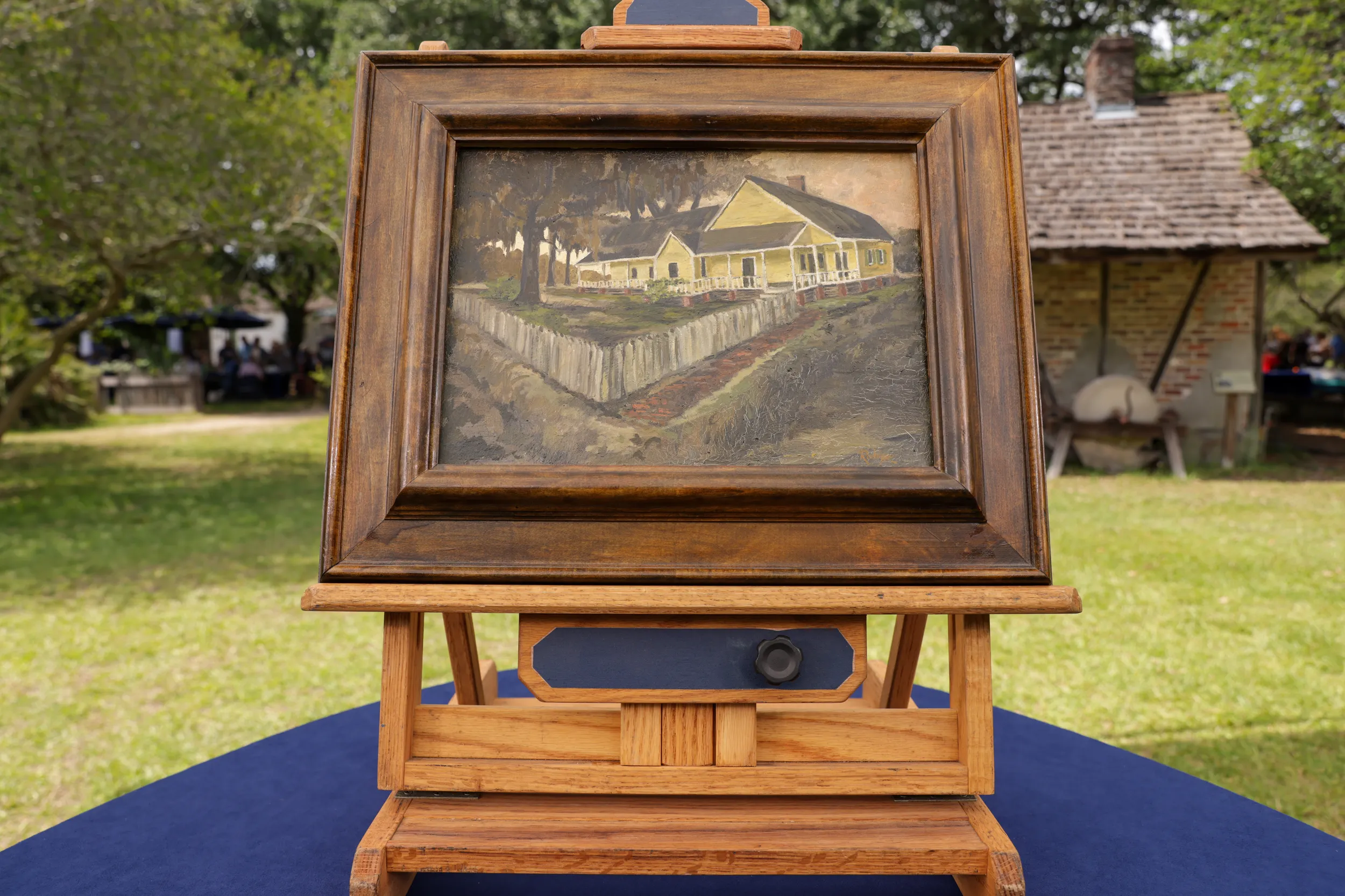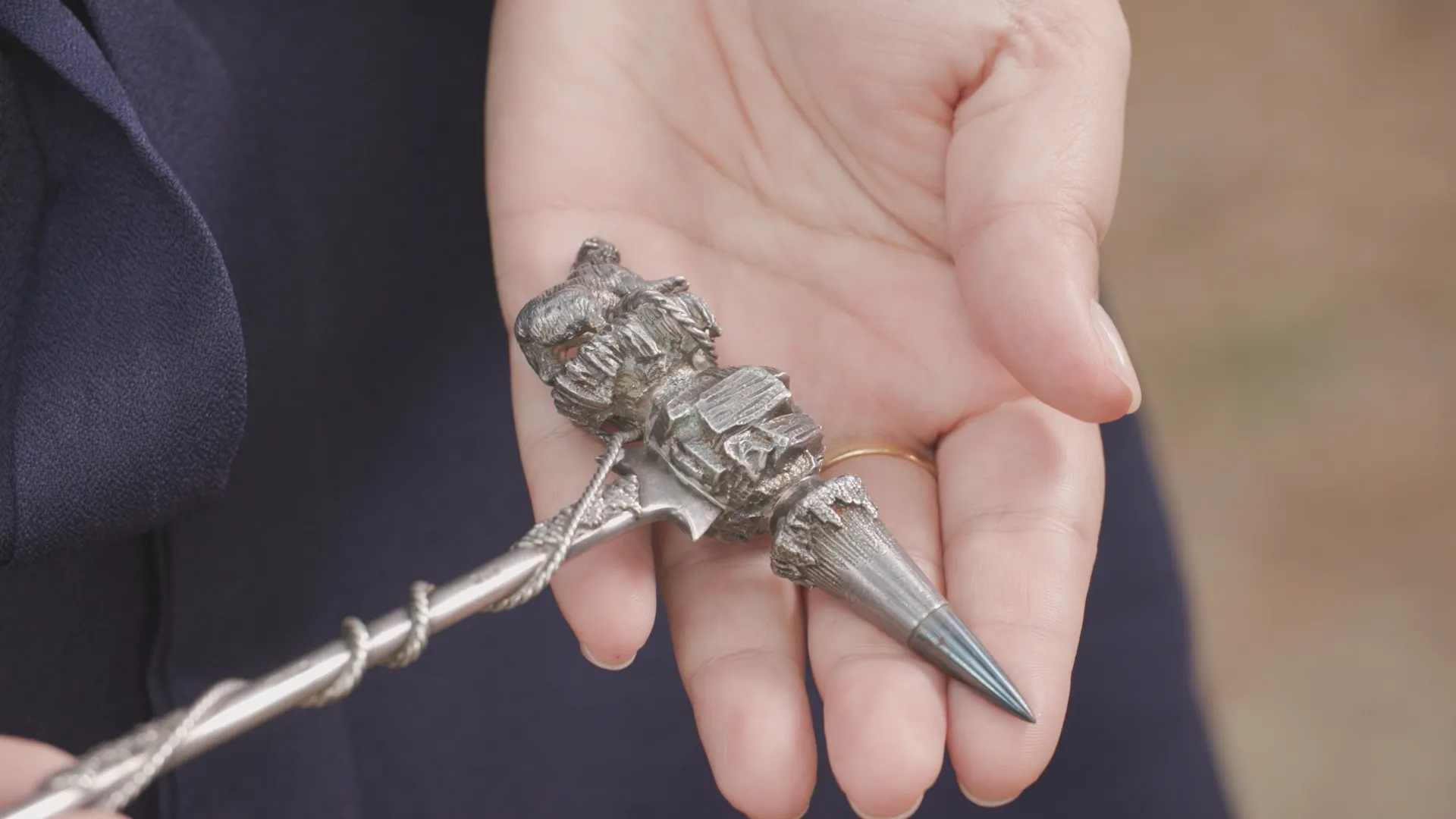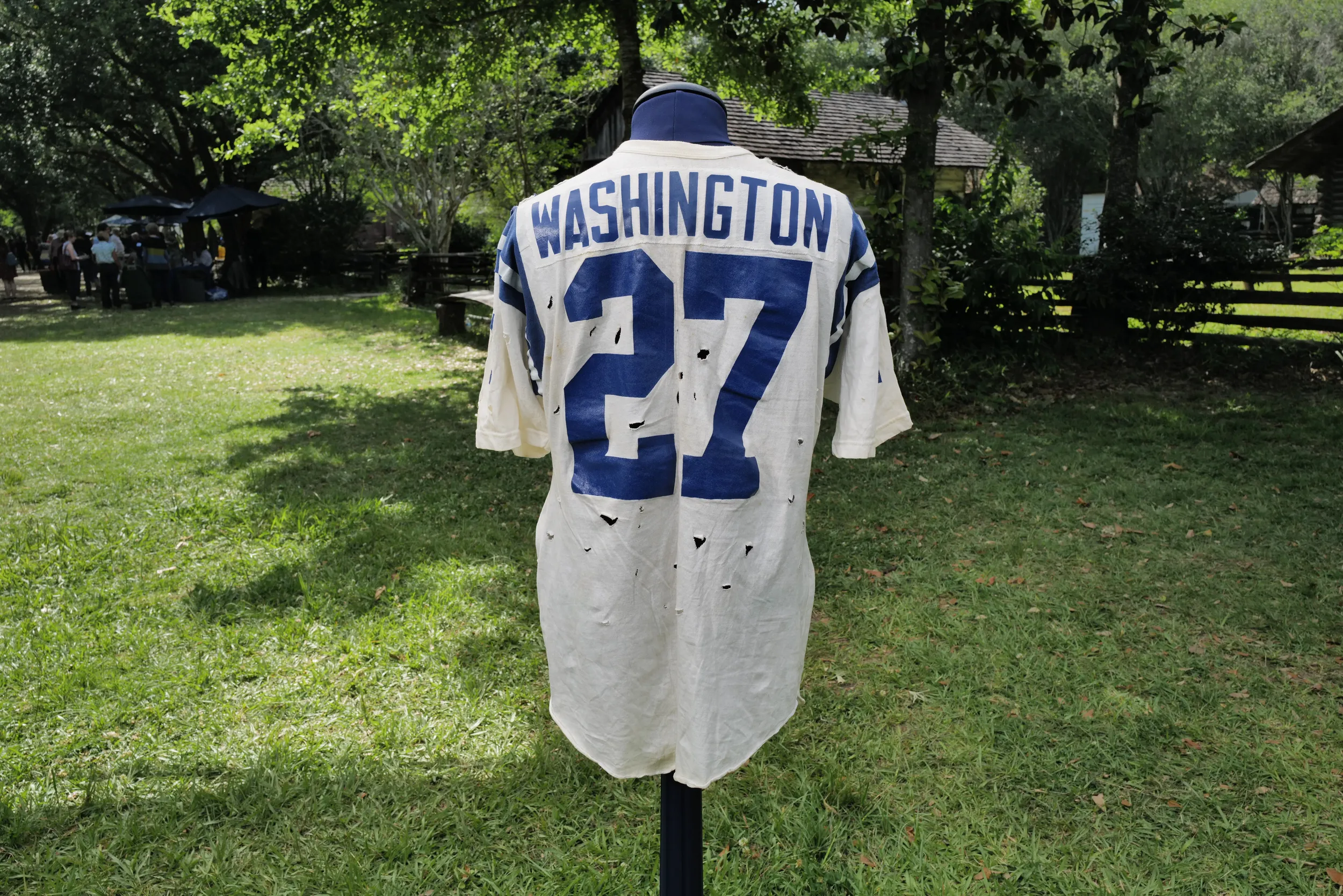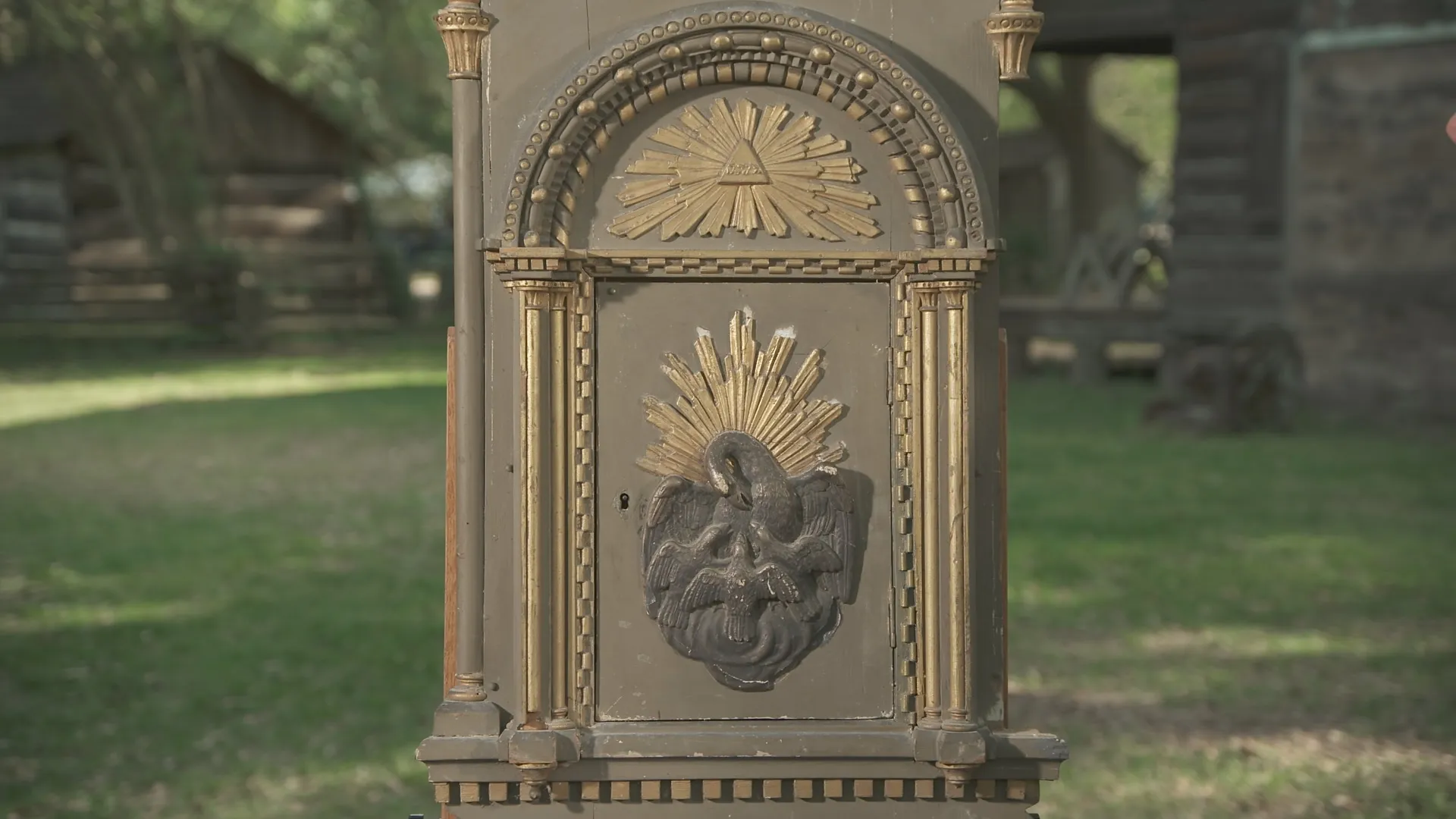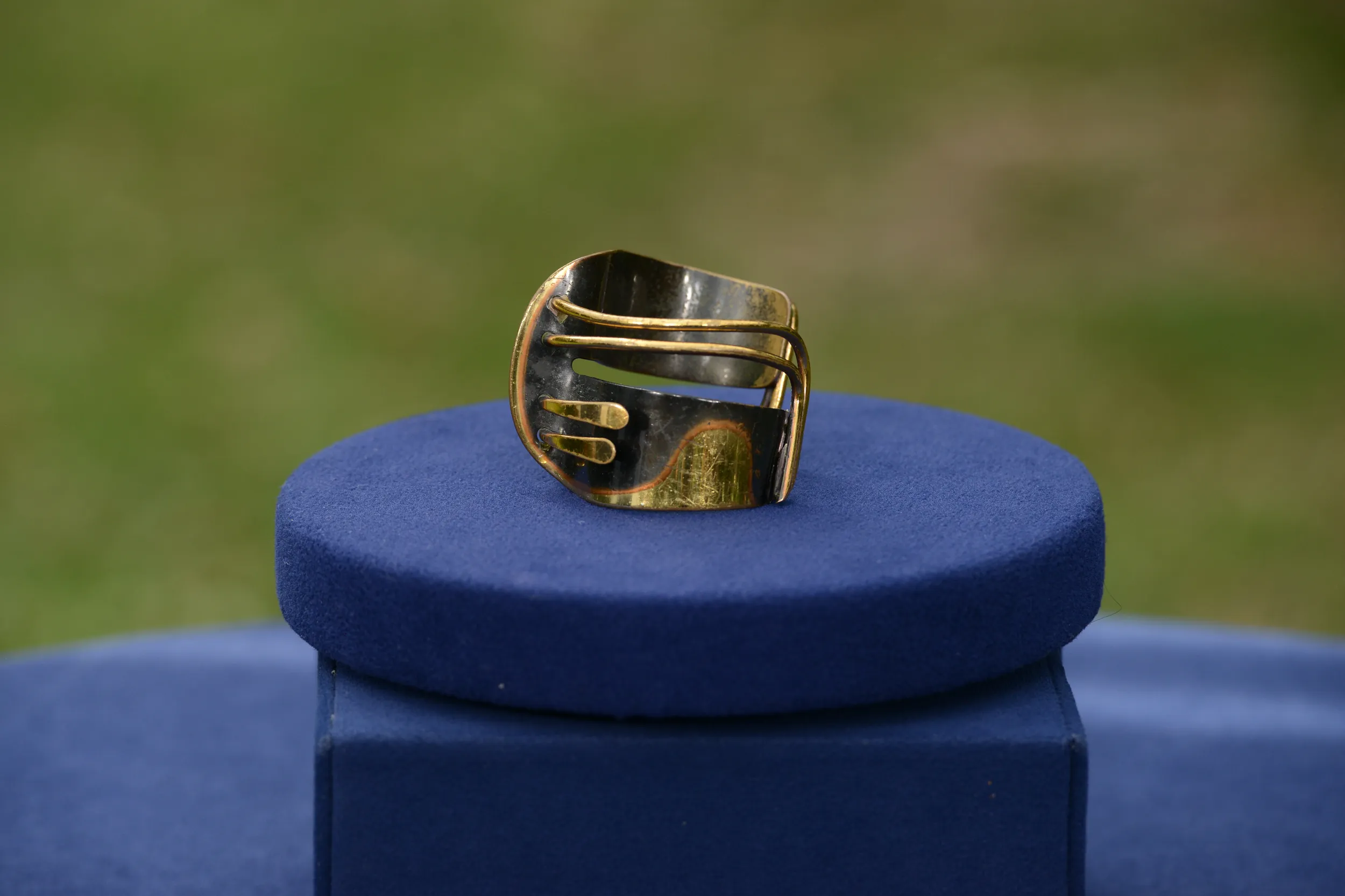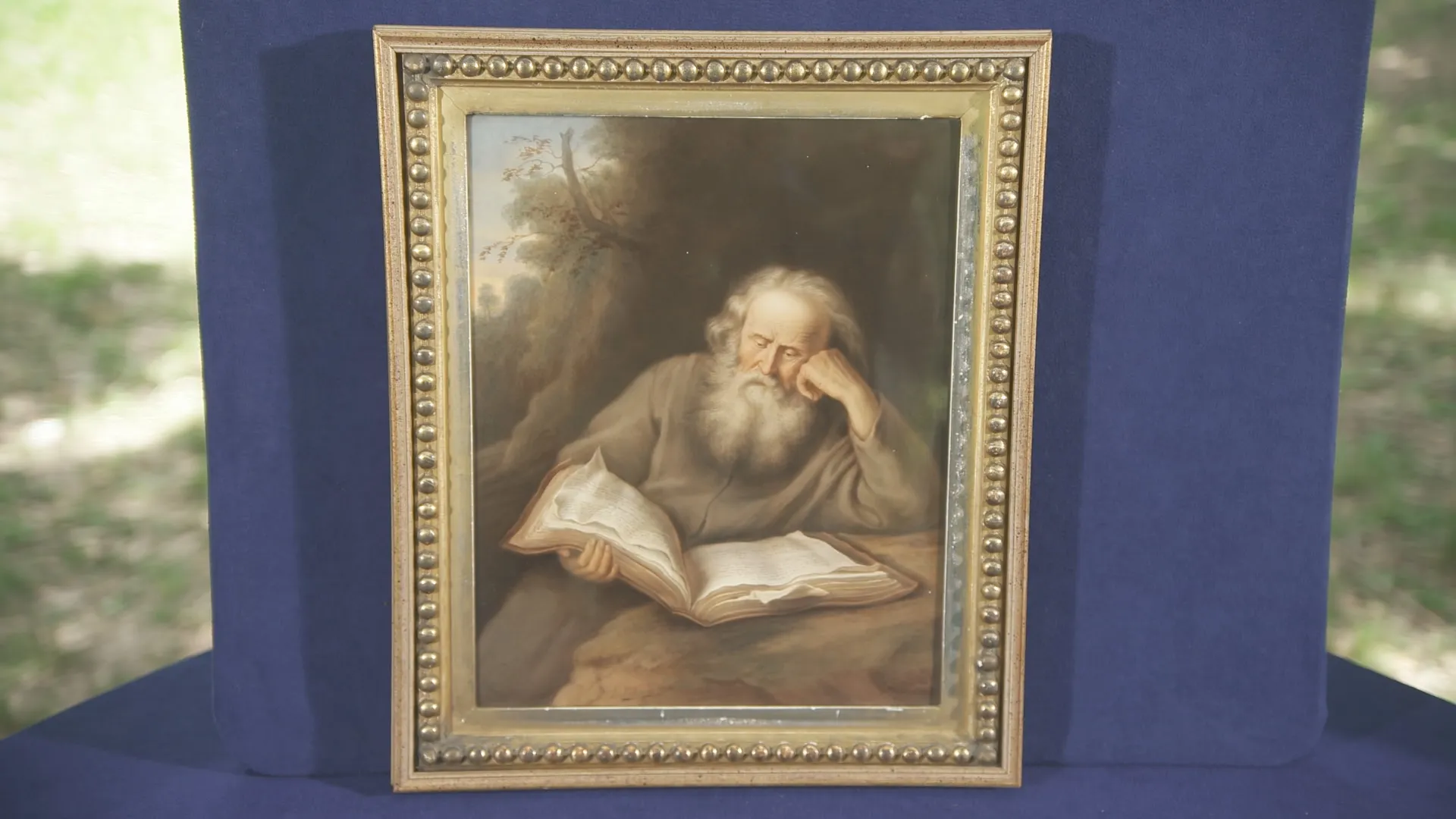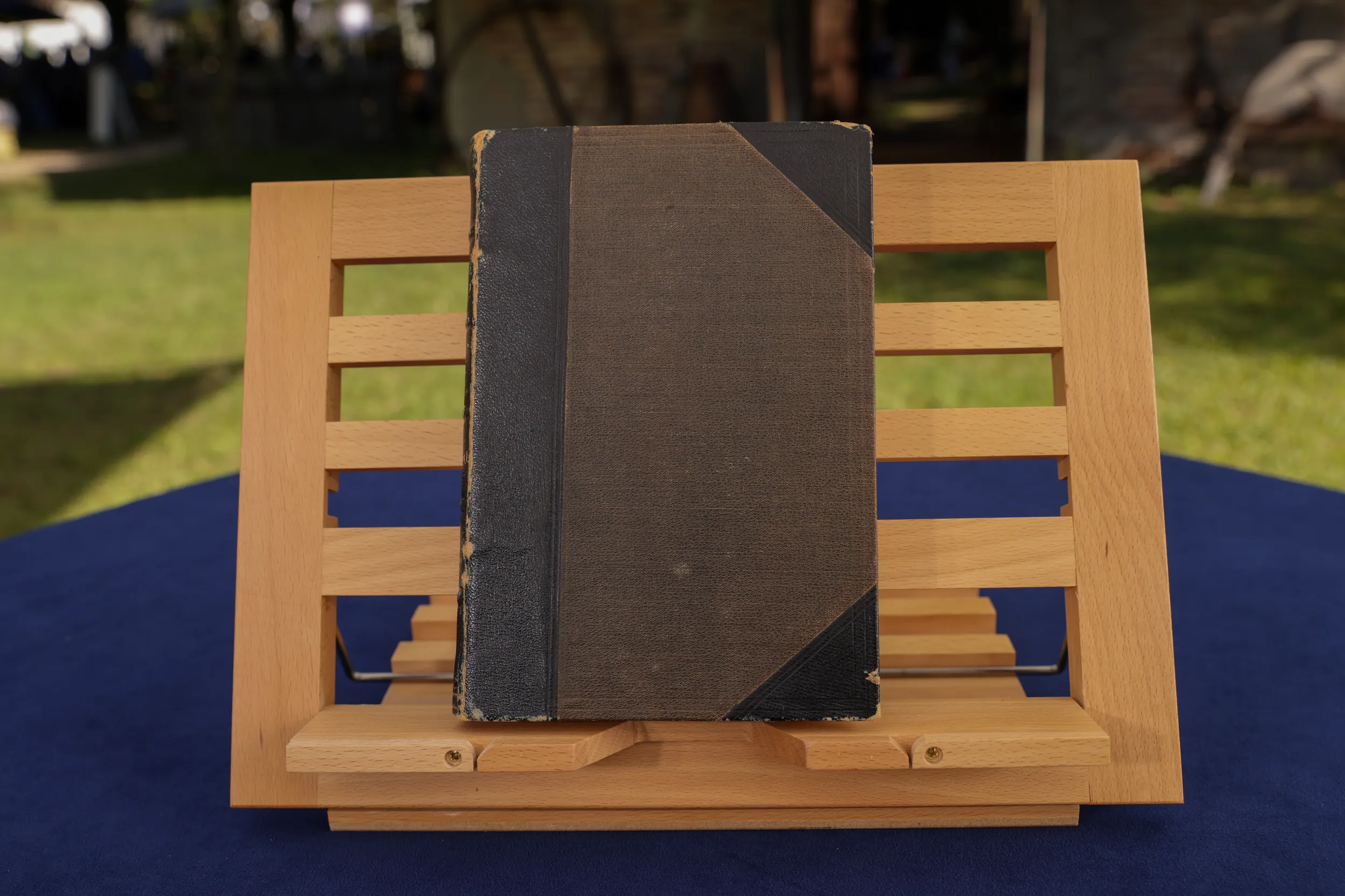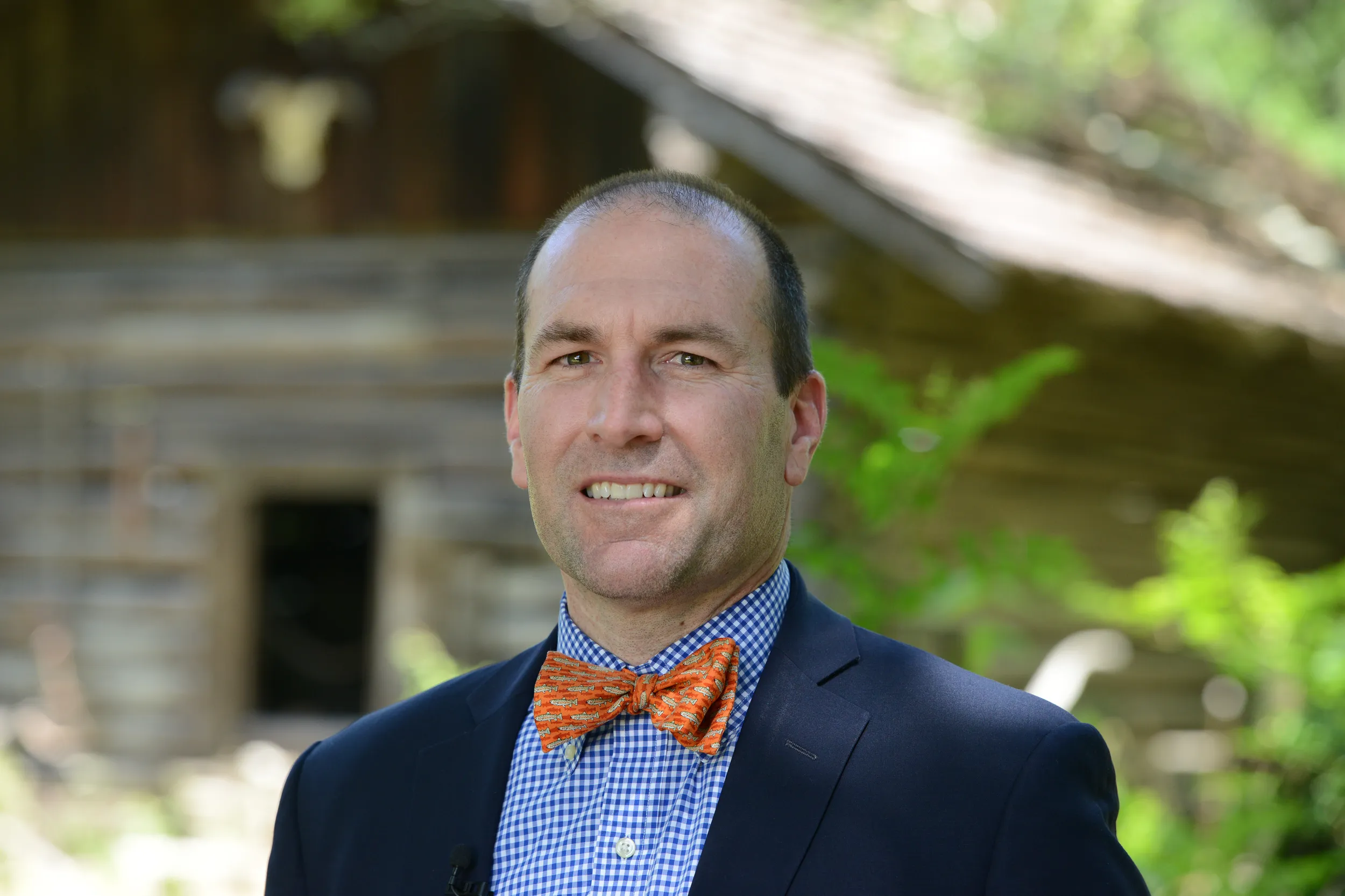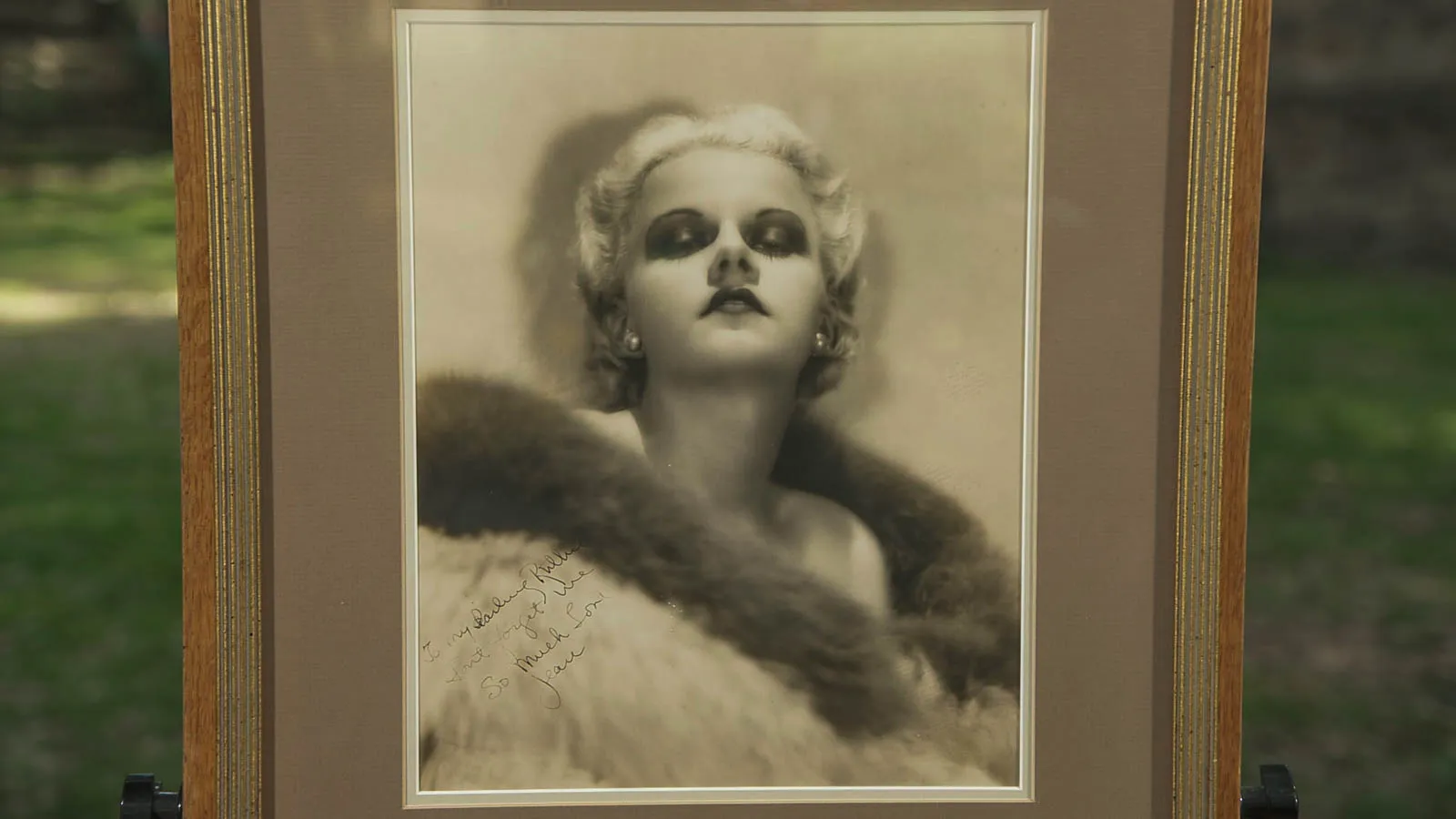HOST: What treasures are turning up at ANTIQUES ROADSHOW in Baton Rouge?
GUEST (laughing): You say jersey, it's really a rag at this point.
APPRAISER: (laughs): It's a rag.
GUEST: I could wear this every day. I mean, maybe not to yoga.
GUEST: (laughs) Oh, my gosh! Are you kidding?
HOST: The Rural Life Museum at Louisiana State University is one of very few places that explore the past through the experiences of Southern agricultural laborers. It has the largest collection of Louisiana and Lower Mississippi Valley vernacular architecture. In this case, modest structures influenced by the climate, cultural traditions, and done using readily available materials. And it also has wonderful gardens planned by one of the museum's founders, Steele Burden. Steele loved nature and was a gifted landscape designer. After World War II, Steele developed and maintained the LSU campus landscape for several decades. Just as his gardens have grown, the collection of artifacts assembled for preservation at the museum has grown, too, to about 20,000 items. Also growing, excitement for learning more about the treasures being brought into ROADSHOW today.
GUEST: That's what I figured.
APPRAISER: This simple cardboard box, in my opinion, is cooler than everything else combined.
GUEST: (laughs)
GUEST: I brought this diamond and sapphire ring that belonged probably to my husband's grandmother, probably from the early 1900s. But I really don't have much history about it. I just think it's a really beautiful ring. And I've usually in the past only worn it, like, if I was getting really dressed up.
APPRAISER: Right.
GUEST: Going to an occasion. But as I put it on to come up here, I thought, I could wear this every day, you know? I mean, maybe not to yoga.
APPRAISER: (laughs)
GUEST: But, you know, I could wear it just as a everyday ring.
APPRAISER: Well, jewelry is meant to be worn.
GUEST: Right.
APPRAISER: And this is about as pretty of a sapphire and diamond ring as you can get. You're right on the timeline. I would date it to the early part of the 20th century.
GUEST: Uh-huh.
APPRAISER: Probably around about 1925. The center stone here is a sapphire.
GUEST: Uh-huh.
APPRAISER: It's about 3.65 carats, and it's flanked by two antique-cut pear-shaped diamonds.
GUEST: Oh!
APPRAISER: Which are each about 75 points.
GUEST: Mm-hmm.
APPRAISER: And then in the gallery of the stone, you have this beautiful, intricate millegraining and filigree work all set with old-European-cut diamonds, which are about 0.65 carats altogether.
GUEST: Uh-huh.
APPRAISER: Now, what makes the ring really special, for two reasons here...
GUEST: Yes.
APPRAISER: ...is one, that it's signed on the interior of the hoop-- the back part of the mark is kind of worn away-- Tiffany.
GUEST: Oh, okay, so it is Tiffany.
APPRAISER: So it's... Tiffany and Company.
GUEST: Uh-huh.
APPRAISER: Tiffany and Company was making the best of the best at this time, and they were using the best of the best materials.
GUEST: Okay.
APPRAISER: So that sets off all my alarm bells to look at the colored stone.
GUEST: Yes.
APPRAISER: Which is a beautiful sapphire.
GUEST: Okay.
APPRAISER: It is a bit abraded. This would benefit from being repolished, potentially even recut, but it's a gorgeous color. It's the kind of color that we like to see in sapphires.
GUEST: Yeah?
APPRAISER: It's like a royal blue. What's important with colored stones is to find out where they were mined, what their origin is.
GUEST: Oh, okay.
APPRAISER: I'm going out on a limb.
GUEST: Uh-huh.
APPRAISER: And my gut tells me that it might have been mined in Burma.
GUEST: Oh, wow.
APPRAISER: Which was known to produce some of the most beautiful and desirable valuable sapphires.
GUEST: Uh-huh.
APPRAISER: You can only have that information made certain... (chuckles) ...by a certification from a laboratory.
GUEST: Oh, yeah.
APPRAISER: I think it would be important to have that done. And then they would also tell us if the stone has been treated at all. Without knowing exactly what it is, but assuming that it's probably Burma...
GUEST: Uh-huh.
APPRAISER: ...conservatively at auction, this ring is in the neighborhood of $30,000 to $50,000.
GUEST: Oh, my goodness, wow.
APPRAISER: So you absolutely...
GUEST: Yeah.
APPRAISER: ...want to get, have that extra homework done.
GUEST: Right. Yeah.
APPRAISER: And probably want to have it insured if you're going to wear it, because the insurance could be upwards of $100,000.
GUEST: Oh, my goodness, okay!
GUEST: It's oil on board. The artist I can't make out, but I know the architect. He's a famous architect in the San Francisco area. I've looked everywhere for this hotel-- can't find it. So I'm here to see if somebody can help us.
GUEST: It was actually just, uh, given to us as a gift from a neighbor who had found it in an attic of the house he had bought. You can see where they nailed different shipping labels on it over the trip. It has some pretty heavy travel scars on it, too, so I would say somebody had a good time with it.
GUEST: What I brought here was my father's Panerai Italian military wristwatch that he got during World War II from an Italian prisoner, because he acted as an, an, uh, as a military interpreter in a Italian prison that was here in the United States. My dad either bought the watch off of a prisoner or traded something or another. I'm not exactly sure.
APPRAISER: Where was this prisoner-of-war camp?
GUEST: It was in Princeton, Texas.
APPRAISER: He was already in the U.S. military.
GUEST: Yes.
APPRAISER: And he was fluent in Italian.
GUEST: Yes. He was from Sicily, and that's what his job was for three years during the war.
APPRAISER: This is a reference 3646. It's a Panerai Radiomir made in association with Rolex. The Radiomir part refers to the radium on the dial, which was perfected by Panerai. The Radiomir part referring to the radium is just that: radioactive, dangerous, and poisonous. Radium used on the dials so that they glow in the dark.
GUEST: Wow.
APPRAISER: This particular model was made for the Italian navy, Italian military. This was essentially a frogman's watch. So this was a diver's watch. It's gigantic-- why? Because the very large strap that once went on this had to fit over the wetsuit.
GUEST: (gasps)
APPRAISER: They had to have the luminous, that Radiomir. They had to be large so they could see them through their goggles. The Rolex part came in with Panerai because Rolex was known for perfecting a waterproof case. So you got the Rolex for Panerai case, and then essentially what you have inside there is a Rolex pocket watch movement. The crystal on there, do you see how that's a little bit yellow?
GUEST: Yellow.
APPRAISER: In the 1920s, '30s, and '40s, until they really perfected the glass, this is a thick, heavy plastic, and over the years, it went from clear white to a yellow. So I'm gonna take this off.
GUEST: Okay.
APPRAISER: And we're gonna see the face, which is black. Between the ingenious of Panerai, the quality of Rolex, the machining of the case, they created an absolute perfect watch.
GUEST: Gee whiz.
APPRAISER: Maybe about 1,000 to 2,000 were made specifically for the Italian military.
GUEST: Panerai is in business today, correct?
8:01 APPRAISER: Panerai is in business today. This one is 1940 to 1945. This is the first one to ever come to ROADSHOW. The issues are the crystal that turned a bit yellow and your dial-- it's a celluloid dial. As we can see, it's starting to buckle a little bit, but it certainly is repairable.
GUEST: Uh-huh.
APPRAISER: So now, in terms of a value, any idea?
GUEST: $7,000.
APPRAISER: In today's market, retail, this watch will bring $50,000 to $60,000.
GUEST: Holy moly. That's a lot more than seven.
APPRAISER: A more mint-condition dial, these have brought up to $100,000 in recent years.
GUEST: Wowzer.
HOST: The Germain Bergeron House was carefully taken apart, moved to the museum, and reassembled in 2005. It is believed to be the oldest standing house built by Acadians in Louisiana, the first generation of immigrants from French Nova Scotia and ancestors of current-day Cajuns. The house was constructed with heavy cypress timber around 1805.
GUEST: I brought my metamorphic library table. It was found in an antique shop in Huntsville, Alabama. My parents just thought that it was cool and it's something that I would like, and so they gave it to me as a graduation present.
APPRAISER: Ooh, you must be a special child to end up with this as a graduation gift.
GUEST: I tried to be good.
APPRAISER: I think you succeeded, clearly. It's got great veneers, a wonderful leather inset top with this gilt-stenciled border. And if you can see this sort of arched grain? It's, it's what we call crotch mahogany.
GUEST: Mm-hmm.
APPRAISER: And it's really the Y of a tree, the branch that gives this great flamed figuring. It appears to be an English Regency writing desk. We don't know exactly who the maker is. Oftentimes, with period furniture, you don't find a maker's mark or a stamp. But what we can tell, in the English furniture directory, this is a known design. There's a cabinetmaker in London named Thomas Gillow. He created Gillows and Company a little later on, and this is sort of emblematic of his type of work. But you mentioned it was metamorphic. Why don't we show what this table's really about?
GUEST: Sure.
APPRAISER: I mean, what, what a, what a fascinating piece. So if we take this and, and open it...
GUEST: Open it up,
APPRAISER: ...it's going to reveal a bit of a surprise, isn't it?
GUEST: Yup, and you flip that back, and you push these little wooden pieces to lock in the arms.
APPRAISER: And if we slide this down...
APPRAISER: ...you end up with a great set of library steps.
GUEST: Yup.
APPRAISER: You've got an oak interior, which provides great strength.
GUEST: A way to reach all of your books on the high shelves.
APPRAISER: Well, for me that's very important, as I'm vertically challenged.
GUEST: Me, too.
APPRAISER: And so this is, this is a great piece of furniture. And metamorphic furniture is something that carries a special interest in a lot of collectors' hearts. It's a really fabulous surprise. Any idea what your parents had to pay for it?
GUEST: They paid about $1,600 for it.
APPRAISER: And do you think they were smart shoppers, good shoppers, or... What do you, what do you think about the value?
GUEST: I think it's certainly worth at least that to me.
APPRAISER: It's a really fine piece of furniture with a tremendous sense of detail that the cabinetmaker put this together. So for being about 220 years old, it's amazing that it's still in such great condition. If it were to come to auction today and be sold in a, you know, a New York auction house in the context of a library sale, I could easily see placing an estimate of $3.000 to $5,000 on it.
GUEST: Awesome.
APPRAISER: Not bad, right? It's...
GUEST: Not bad at all.
APPRAISER: That's quite a graduation gift.
GUEST: It is.
APPRAISER: Your parents, unfortunately, have set the bar pretty high. Now I'm thinking about my own children. What am, what am I going to have to, to get them? I'm not sure I can top 'em on this.
GUEST: I moved up to New York for my divorce party, and I fell in love with the place. And so I stayed there for a while. And I was living out in Ossining, and, uh, around a... ...open-air market, and the temperature dropped, so I bought a fur coat. And, um, walking around the market a while later, feeling inside the pockets and inside the liner, I find this thing.
APPRAISER: This is a very, very, very Art Deco match safe. Now, I know you know this, but it's Cartier.
GUEST: Yes, it is.
APPRAISER: It's signed "Cartier, Paris, London, New York."
GUEST: Yeah.
APPRAISER: That's like a trifecta-- that's just excellent. When we close it, you see there's a little click here. (box clicks) And you have some little rose-cut diamonds. Just always that extra, extra touch. But what I love is this pinstriping, black and white, a lot of high-contrast enamel, with the little chevrons in between it. And there's not one chip on this. How much did you pay for the fur coat?
GUEST: $50, if.
APPRAISER: Now, I, I know at one time, you told me, somebody offered you money for this.
GUEST: $2,000 a couple years ago.
APPRAISER: To, to replace this, today, I'm gonna double that price. $4,000 to replace it today.
GUEST: Just $4,000? You said, and, good, but come on.
APPRAISER: She's wants me-- she's pushing me up. (all laughing) She's bargaining with me-- nobody does that!
GUEST: (laughs)
GUEST: I acquired it from a lifelong friend that passed away, and, and it was left to me by he and his widow.
APPRAISER: Do you know where he got it?
GUEST: I, I don't. Uh, he was a big collector of autographs, of movie star autographs, and I had admired this one through the years. And so when he passed, it, it, his widow saw that I got it.
APPRAISER: Yeah, and we're ignoring the, the signature in the room here, which is down there on the lower left.
GUEST: Mm-hmm.
APPRAISER: It reads, "To my darling Ruthie, don't forget me. So much love." One of the things that is, is pretty widely known is that her mother signed most of the photographs...
GUEST: Yes.
APPRAISER: ...that we see out there in the market. Mama Jean, we call her, and she would...
GUEST: (laughs)
APPRAISER: When she would sign for fans, she wrote what fans would want to see, "Jean Harlow." One of the tells, as I think you've probably picked up on, is that Jean would just sign "Jean."
GUEST: Yes.
APPRAISER: And the signature does look good to me. She was born in 1911, and she died so tragically young, in 1937. Sadly, she'd only done a f, a few fil... Well, a few-- for the short time she had, she has quite a body of work. She was a sultry, the f, the original blonde bombshell...
GUEST: Absolutely.
APPRAISER: Which, a lot of people think, Marilyn Monroe tried to...
GUEST: Yup.
APPRAISER: ...mirror herself off of Jean's career. Marilyn would have been 11 when she died, so she very well did look at her as someone she wished she could be or aspire to. This image is, uh, you know, at the peak and the height of her fame. It's, probably dates circa 1935.
GUEST: I understood that she bleached her hair out, and the bleach got into her blood system and went to her kidneys, and she died of kidney failure.
APPRAISER: So she, she actually did die of kidney failure. The issue is, it's the, it wasn't peroxide that killed her. She actually, as a child, suffered from scarlet fever.
GUEST: Oh, okay.
APPRAISER: And she had a number of other health issues. And so what unfortunately happened is, when she started showing symptoms-- they also suspect she may have had hypothyroidism-- these symptoms were masked because she was drinking pretty heavily.
GUEST: Oh, okay.
APPRAISER: And so some of the, the bloating and the, the other symptoms that maybe would have been picked up on, they all thought was something else. And so it didn't go diagnosed until it was very late.
GUEST: Oh, I see.
APPRAISER: And to be honest, even if they had diagnosed kidney failure, they didn't invent kidney dialysis until years later.
GUEST: Oh.
APPRAISER: And they didn't do transplants until the '50s. So they probably couldn't have saved her anyway, which is just so tragic. But all of that means that she signed very few photos in her lifetime. And so, although most Hollywood photos, unless you're the biggest stars, are worth a m, smaller amount of money, Jean Harlow photos like this, when they come up for sale, routinely sell usually in the $3,000 range at auction?
GUEST: Mm-hmm-- mm-hmm.
APPRAISER: Now, the inscription reads, "To my darling Ruthie." We could, probably could do some research and determine who Ruthie is. Then you're looking at something that could be more like $5,000 to $7,000.
GUEST: I had always loved the photograph, and my friend that passed away, it was one of my, his favorite, so, uh, I was honored to, to have it.
GUEST: That is a painting that I've had on my wall for at least 12 years. And it's a Petter. And I talked to some woman about it. They said, "Well, if you got the right Petter, you got some luck going on." I, so, I don't know, so I brought it.
GUEST: These are candelabra. I got these off the mantel of the fireplace at my grandmother's house in Opelousas back about 30 years ago. After she died, my folks said, "Y'all can go through the house and take what you want." They are living on my mantel over my fireplace.
GUEST: They belonged to my grandmother, and my father gave them to me.
APPRAISER: Do you like these pieces?
GUEST: I do, I love them. I love the turtle and I love the frog.
APPRAISER: They're really colorful and very interesting.
GUEST: They... Yes, they are. And they were on my grandmother's mantel ever since I was a little girl, I could remember.
APPRAISER: So both these pieces were made by Union Porcelain Works in Greenpoint in Brooklyn, New York. They both date from approximately 1879, which makes them early in the production of porcelain in the United States. There are examples just like these that are white, only porcelain body. Both of these are polychromed, which makes them special. One of the people most responsible for creating these pieces was Karl Müller, who was a German, well-trained in Germany as a sculptor, and he is the man who is given credit for making these pieces. And both of these guys are leaning on a pitcher plant, which is an unusual thing that apparently grew in the area of Union Porcelain Works. We will show the marks on the bottom. Just the "UPW" for Union Porcelain Works in, in black slip. And Mr. Turtle has a little more elaborate mark, which simply says "Union Porcelain Works, Greenpoint, New York." We've got a couple of things going for us that are important. The fact that both of these are polychromed and they're very early part of American porcelain history, and they're just cute as they can be. I would say in an auction setting, Mr. Frog would probably bring somewhere between $1,000 and $1,500. The turtle, more-- maybe in the $1,200 to $1,500, $1,500 to $2,000 range. So they're very special and they're very nice.
GUEST: Wow, that's great.
APPRAISER: You still like 'em?
GUEST: I love 'em, I really do love 'em. And I'll keep them, and remember my grandma.
APPRAISER: They are sweet.
GUEST: In 1995, I worked for "U.S.A. Today," and I organized an event in Dallas that summer.
APPRAISER: Okay.
GUEST: And Muhammad Ali came to the event. And he was already ill, but he was able to walk in. And when the event was over, Muhammad Ali had drawn this scene with an airplane and a rocket.
APPRAISER: And when you talk about Ali being ill, he was suffering from Parkinson's. A lot of celebrities are also artists, and Muhammad Ali is no exception. A lot of his drawings have been the boxing ring. So a lot of times, it will be him in a ring, tiny people, and then this huge crowd all around him. But it's fun to see him do something different. When you're valuing sports memorabilia, it's all about the historic importance of the person themselves, but it's also about the provenance and the authenticity. And you've got it all.
GUEST: I've got a picture of us that day. I was much cuter then. (both laugh)
APPRAISER: This not being boxing-related, but also knowing exactly where it came from, and it's kind of a fun scene here, I'm probably going to put, as an auction estimate, $2,000 to $3,000 on it.
GUEST (laughs): Yeah! Ah, I am very... Pleasantly...
APPRAISER: And I'm not including the soup stains thing, all right? Not including the soup stain!
GUEST: (laughing) Yeah, very surprised! I'm knocked out! (laughs)
GUEST: It was painted by George Rodrigue, who internationally is known as the Blue Dog artist. It was done in 1969, when he was probably about 25 years old. The title is on the back of the painting, and it's called A House in Washington. And he did work like this early in his career because he was concerned that these style homes would, through progress, be taken down or sold or destroyed. I acquired it through a local estate sale company.
APPRAISER: And do you mind revealing what you paid for the painting?
GUEST: Uh, I paid $4,300.
APPRAISER: When did you purchase the painting?
GUEST: In November of 2021.
APPRAISER: And did you know what you were getting?
GUEST: Yes, I did recognize the name. I actually bought it because my two grandsons are Cajun, and I guess that's really why I purchased it.
APPRAISER: George Rodrigue was born in 1944 in New Iberia, Louisiana. Went to school at the University of Southwest Louisiana, in Lafayette. He then went on to further his training in Los Angeles and then came back to Louisiana, to his hometown. He wanted to preserve the Cajun culture and painted, during that early first few years of his return, primarily bayou landscapes. So as you see here, it's an oil on canvas. It's a classic Creole cottage with foreground trees covered in Spanish moss, and it's a beautiful example of Louisiana painting and bayou landscapes. George Rodrigue was, as you note, famous for being the Blue Dog painter. What can you tell me about the Blue Dog?
GUEST: He was commissioned to do one of the Jazz Fe, Fest posters, and if I'm not mistaken, it was the one for, um, Pete Fountain. And he decided to put the Blue Dog on that poster, and it was a huge hit.
APPRAISER: Blue Dog became iconic...
GUEST: Yes.
APPRAISER: ...as maybe a symbol of New Orleans and Louisiana.
GUEST: Yes.
APPRAISER: He was a successful painter as a commercial artist. Designed three Jazz Fest posters with the Blue Dog, and also a very famous Absolut Vodka ad. This painting, it's signed lower right and titled on the back, with also the George Rodrigue stamp on the stretcher, so that helps to authenticate the painting. It is in its original frame, and that does tend to add value. There is some crazing in the painting. I think there are definite benefits to having paintings conserved. It definitely would add value and also quality to the work. Do you have any ideas as to what it might bring if you were to sell it?
GUEST: I know what they said that it was verbally appraised at, $20,000. They were asking 13, and I paid significantly less than that. So do I know what it's really worth? I would hope that it was, be worth at least $4,300, 'cause that's what I paid. (laughs)
APPRAISER: I think if it were in perfect condition, might bring $20,000 to $25,000 at auction. But in its current condition, I would say maybe $12,000 to $18,000 would be an appropriate, and possibly conservative, auction estimate.
GUEST: Okay.
APPRAISER: It's a wonderful example of Louisiana painting, and we're happy to have it.
GUEST: Thank you. I'm thrilled to be here.
APPRAISER: (laughs) Good.
HOST: A shotgun-style house from Tally-Ho Plantation was built in the late 1800s for sharecroppers and tenant farmers. This type of house has a linear architectural style that is one room wide and several rooms deep, with no hallway, and was commonly used on plantations and lumber mill communities in Louisiana. The "shotgun" name comes from lore that a shot fired through the front door would pass through to the back without hitting interior walls.
GUEST: I brought an ice pick that my in-laws gave me. They found it at an estate sale, and that it's from the late 18th, what, 1800s? I've seen the matching punch bowl online from an auction house, but other than that, I don't really know much.
APPRAISER: How much do they pay for it at the estate sale?
GUEST: $45.
APPRAISER: What you've brought us today...
GUEST: Mm-hmm.
APPRAISER: ...is a Gorham sterling silver polar bear ice pick. And it's not a punch bowl, but it has a matching ice bowl. I've seen matching tongs for the ice bowl.
GUEST: Mm-hmm. Okay.
APPRAISER: I've seen matching spoons. Never seen an ice pick.
GUEST: Never?
APPRAISER: Never.
GUEST: Wow.
APPRAISER: You're right, it dates to the late 1800s.
GUEST: Mm-hmm.
APPRAISER: Gorham started making these in about 1870.
GUEST: Okay.
APPRAISER: And they made them till about 1880s.
GUEST: Okay.
APPRAISER: But I can narrow that date down a little bit further, because it's got some exciting inscriptions on this. Some stamps.
GUEST: Mm-hmm, yes.
APPRAISER: And the retailer tells us when they were in production. Crosby, Morse, and Foss was a retailer in Boston to the 1870s.
GUEST: Mm-hmm, okay.
APPRAISER: So we can date this piece to about circa 1870.
GUEST: Wow, that's incredible.
APPRAISER: Yeah. The United States purchased Alaska in 1867.
GUEST: Mmm!
APPRAISER: So Alaska, polar bears.
GUEST: The bears.
APPRAISER: The polar exploration is on everybody's mind.
GUEST: Yes.
APPRAISER: So with our rarity today, retail value...
GUEST: Mm-hmm?
APPRAISER: $4,500.
GUEST: Oh, my gosh! That's incredible, wow! I would have never guessed that. It's a lot more than that $45. (laughs)
APPRAISER: A couple zeros more.
GUEST: Yeah.
APPRAISER: Nice jersey-- it's riddled with holes.
GUEST: (chuckles): You say jersey, it's really a rag at this point I think but -
APPRAISER: (laughs): It's a rag.
GUEST: Yeah.
APPRAISER: Tell me about it, who is, who's Washington?
GUEST: Well, that's Joe Washington. He played for the Baltimore Colts when there was such a team, and this came from his most famous game. It was a 1978 Monday Night Football game with Howard Cosell in the booth, and the game was incredible.
APPRAISER: Washington and, and his Colts are facing off against the Patriots, right?
GUEST: Correct.
APPRAISER: Okay, why was it such an amazing game?
GUEST: Well, first, on a personal level, it was amazing 'cause I was a 16-year-old kid at the time...
APPRAISER: (chuckling)
GUEST: ...and a ball boy for the Baltimore Colts. So in the locker room before the game, Joe came up to me. He had four of these jerseys nicely folded in a neat little pile and a pair of scissors. And he asked me to cut holes all throughout them. I'd been with the Colts since I was 11, uh, working at games and helping out, and so I had never had a player ask me to do this. I was confused, but he explained it to me. They're tear-away jerseys, and that was going to help him, as a running back, get away from defenders.
APPRAISER: Quite a strategy. So what's, what's fun is that it worked, right?
GUEST: The guy had the game of his life.
APPRAISER: (laughing)
GUEST: The Colts were losing. They were big underdogs in the game. He, Joe ended up being involved in three touchdowns in the fourth quarter alone. He threw for one on a halfback option, he caught a touchdown pass, and, with a minute and change left, he ran a kickoff back 90 yards to win the game for the Colts. So it was a huge victory for them and performance for him.
APPRAISER: And to this day, only player ever to do that. To throw a touchdown, catch a touchdown, and return a kickoff for a touchdown.
GUEST: And he did it all in one quarter.
APPRAISER: So this hole-riddled cloth... (laughing) ...this rag, this was part of that historic performance. So he wore this for that game.
GUEST: The four that I cut the holes in, he went through all four of them. And as a kid, a ball boy on the sideline, I thought it was kind of fun and funny...
APPRAISER: (laughing)
GUEST: ...as it was going on, because I'm watching this guy, and he's doing so well, and they keep grabbing him and they can't get him, because he's, they're grabbing the holes and ripping it. The NFL actually ended up banning tear-away jerseys.
APPRAISER: Looking at the jersey, of course, the back is riddled with holes.
GUEST: Right.
APPRAISER (laughing): Now, my favorite part, of course, is, you want to talk about riddled with holes. I mean, here's tear-away at its finest.
GUEST: Right.
APPRAISER: Uh, torn away-- number 27, the seven's gone. (laughs) So, you know, Joe ran hard.
GUEST: Joe had an incredible night, he had an incredible career, and he's a wonderful human being, so it's been fun to keep up with him through the years. Uh, he and I speak every once in a while. He knows that I still have this, uh, piece of, uh, memory and history from that night, and, uh, it brings me a lot of joy and memories. If you had told me when I was a 16-year-old boy... (chuckling) ...in that locker room cutting holes in this thing, that as a 60-year-old man, I'd be standing here talking to someone about it, I don't think I would've believed that.
APPRAISER: Did Joe give you the jersey?
GUEST: No-- that's probably one of the funny parts of this story, is... (chuckles) You know, as a ball boy, one of the things you do is help clean up the locker room after the game. And I asked Marty Daly-- I saw this and one other, there were two of them balled up on the floor with a bunch of trash and tape that had been cut off the ankles and all that. Marty said, "Yeah, we're not gonna do anything with them. You're, you're... What are we going to do with them? You can go ahead and take 'em." And this one, when I got home, I actually used thumbtacks and put it up on my wall, uh, in my childhood bedroom. And it stayed there for a number of years before I, uh, grew up a little and grew out of it, I guess.
APPRAISER: I mean, it already had holes.
GUEST: It had plenty of holes already. (laughing) So I added a couple more small ones, yeah.
APPRAISER: For a piece like this, I want to talk to you about insurance value.
GUEST: Mm-hmm.
APPRAISER: I want to ta, I don't want to talk auction value. You're not gonna sell this, and I know you're not, right? And I'd tackle you if you tried.
GUEST: No, I'm not gonna sell it.
APPRAISER: Um, insurance-wise, we're looking at $6,000 to $8,000...
GUEST: Mm-hmm.
APPRAISER: ...is right around what you could expect to, to place on this for insurance.
GUEST: Okay.
APPRAISER: Yeah.
GUEST: Fantastic.
APPRAISER: Yeah-- really awesome piece, man.
GUEST: Well, thanks for having me here today. (laughs) And it's been really neat to be able to share a little bit of Joe Washington and the old Baltimore Colts with you. (laughs) It's been a lot of fun.
APPRAISER 1: Id Software is one of the most important software companies of the late 20th century. Back in, I think it was '94 or '96, they did a huge release of all of their previous games. You and I are about the same age...
APPRAISER 2: Quake!
APPRAISER 1: Yep.
APPRAISER 2: Oh, my good... Quake! You know how long I played Quake with my brother? Doom. That's prime t... Oh,
APPRAISER 1: Doom... Hexen.
APPRAISER 2: Hundreds of hours playing that game.
APPRAISER 1: Till our fingers bled.
APPRAISER 2: This was actually selling for more money back in 2008 to 2012, where we have results sold upwards of $750, $850 for this. But most recently, one factory-sealed in the cellophane...
APPRAISER 1: Mm.
APPRAISER 2: ...just brought $350 at auction.
APPRAISER 1: Yeah.
APPRAISER 2: Still a great piece that you don't s, typically see here.
GUEST: I got this for Christmas a couple of years ago from my parents.
APPRAISER: Mm-hmm.
GUEST: I found this in an antique store down in New Orleans. Was told I didn't need it, and then they surprised me for Christmas with it.
APPRAISER: Right, wow.
GUEST: So I was very excited when I ended up opening it.
APPRAISER: What drew you to it in the first place?
GUEST: Um, just the ornateness, and I'm Catholic, as well.
APPRAISER: Right.
GUEST: And so, the tabernacle...
APPRAISER: Uh-huh.
GUEST: ...and the church and all that.
APPRAISER: Right.
GUEST: And then also the pelicans on the front...
APPRAISER: Yeah.
GUEST: ...which is Louisiana-related, it's on our n, on our flag.
APPRAISER: It's also a Christian symbol. Do you know what the story of the pelican is?
GUEST: I did a little research on that.
APPRAISER: Mm-hmm.
GUEST: And apparently, when mom pelicans cannot feed their babies, they will pierce their breast and feed them blood, which represents the body and blood of Christ.
APPRAISER: Yes, exactly, his sacrifice for mankind.
GUEST: Sacrificing, yes.
APPRAISER: So it's a very fitting thing to have on a tabernacle door. And it would have been, uh, uh, attached to a much larger scheme. The door would have opened to contain the items that were used in communion. The tabernacle itself just means a sacred space.
GUEST: Right.
APPRAISER: And they come in all different shapes and sizes, all different forms. And they were very popular in the 15th, 16th, and 17th centuries, especially in Italy and, and other areas in Europe, in France.
GUEST: Yeah.
APPRAISER: And later on, they became a little bit more simplified, like this. But they always have this sort of architectural framing. So on here, you have these columns, and you have this intricate egg and dart border here, the spirals, and these beads. This is quite a curious symbol here. Could be Hebrew. Gray painting, uh, and gilding like this is a feature that you often see on Italian furniture of the sort of 18th and 19th century. Also in French, we think this is probably French. I...
GUEST: Do you know what century it would be from?
APPRAISER: It's more likely to be from the early 19th century, possibly over into the late 18th, but I, I certainly do not think it's 17th, uh, century.
GUEST: Okay.
APPRIASER: It's pine and other woods behind. We can see some of those have been replaced. And you can see that it's kind of fragmentary. You've got a missing column here.
GUEST: Mm-hmm.
APPRAISER: And I suppose it kind of s, uh, fits that it would have been removed from a church. It would have s, been sort of built in. So you wouldn't necessarily expect to have all of those pieces.
GUEST: It had all the other pieces with it.
APPRAISER: It did?
GUEST: At the antique store, but we didn't... This is the only piece that I was given. It had the whole setup.
APPRAISER: The whole, the whole...
GUEST: It had the whole wall.
APPRAISER: Really?
GUEST: Mm-hmm, yeah.
APPRAISER: Oh, and how far did that extend?
GUEST: I mean, was... It was pretty big.
APPRAISER: Really?
GUEST: Yeah.
APPRAISER: Oh, okay.
GUEST: But I, I... We, we didn't get it.
APPRAISER: Of course.
GUEST: We just didn't have room for it.
APPRAISER: Sure, I see. Well, this is probably the most exciting part of it.
GUEST: This is what, this is what drew me the most, too.
APPRAISER: I think, in a retail setting, anywhere between $1,000 to $1,500 would be...
GUEST: Okay.
APPRAISER: ...uh, uh, a s, a suitable asking price.
GUEST: Yeah.
APPRAISER: (murmurs)
GUEST: I used to watch ROADSHOW with my grandmother growing up. Drinking tea, watch the ANTIQUES ROADSHOW, and so I was so, super-excited to come.
GUEST: I brought a collection of porcelain vases that my grandmother, who died in 1950, had. I don't know anything about them. Why anybody would want little tiny vases, I don't know.
APPRAISER: Yeah. And I think they were made either for doll houses, but they were just made for collections in displays and cabinets.
GUEST: Oh, okay, okay.
APPRAISER: But there's two of them that I keyed in on.
GUEST: Oh, yeah?
APPRAISER: We got a pair that are identical, that are all hand-painted. The marks on the bottom tells us that they were made by Meissen porcelain in Germany.
GUEST: Okay.
APPRAISER: Near Dresden. And by the marks on these, I can tell that these were made between about 1850 and no later than 1924. They're beautifully made, and if these were maybe three or four or five or six inches tall, they might sell for $100 or $200 apiece. But because they're so tiny, they're actually worth more.
GUEST: Oh! Okay.
APPRAISER: And so these would probably sell for around $250 to $300 each.
GUEST: Each? Yeah?
APPRAISER: So it'd be $500 or $600...
GUEST: Oh, fun-- tiny vases.
APPRAISER: For these little tiny vases.
GUEST: Oh, that's fun.
APPRAISER: I think they're just terrific.
GUEST: It's a bracelet that I have played with ever since I was six years old. It was my mom's. She gave it to me to play dress up with, all these years, and I kept it, and I just thought it was really a cool-looking bracelet.
APPRAISER: Well, you're right about that. Where did she get it? Do you have any idea?
GUEST: I don't know. She doesn't remember where she got it. She remembers that it was a favorite bracelet of hers, but she doesn't remember where she bought it. She's 95 years old now. As I was watching PBS, I wasn't really paying a lot of attention. I was just hearing "jewelry," and I looked up at the television and saw a picture of the bracelet.
(both chuckling)
GUEST: So I ran up the steps to go get the bracelet, came running back down the steps, and the television show was off.
APPRAISER: Yeah.
GUEST: And I couldn't figure out which PBS station it was on, 'cause the kids in the house had changed the station. So I had no way to find out anything about the bracelet other than it was on PBS.
APPRAISER: Do you have any idea what it might be worth?
GUEST: The ten dollars that my mother probably paid for it? (laughing): That's about it.
APPRAISER: When you brought it to me, you noticed I kind of had an immediate reaction.
GUEST: Yeah.
APPRAISER: And I looked at one of my colleagues, and I blurted out who it's by. It's by a famous Modernist artist named Art Smith.
GUEST: Okay.
APPRAISER: Yeah. Very prominent figure in the Modernist movement. This is really a piece of jewelry that is art, and it's a very rare piece. It's a cuff bracelet that's called the Modernette.
GUEST: Okay.
APPRAISER: And it was tough to find similar pieces like that. He made this in copper and brass. The other ones we found were silver. And lately, the movement for Modernette pieces has just gone crazy. Now, Art Smith was born in Cuba. He's an Afro Cuban American who moved from Cuba to Brooklyn, New York...
GUEST: Wow
APPRAISER: ...and he eventually ended up in Greenwich Village.
GUEST: Oh, okay.
APPRAISER: Which was a center for all the hip, modern things that were going on at that time, in the 1940s and '50s.
GUEST: Oh, okay.
APPRAISER: And that's where this bracelet is from, the late 1940s.
GUEST: Oh, wow. Really? Wow.
APPRAISERS: He was picked up by Bloomingdale's, and he was commissioned from famous people like Eleanor Roosevelt to Duke Ellington.
GUEST: Oh, wow.
APPRAISER: His jewelry was featured in Harper's Bazaar and Vogue magazine. It is signed on the underneath of the cuff.
GUEST: Oh, okay!
APPRAISER: And it says "Art Smith."
GUEST: Oh, wow! I didn't even realize it had any kind of signature on it.
APPRAISER: Well, it's got a little bit of discoloration on the inside.
GUEST: Okay.
APPRAISER: So it wasn't easy to see. We tried to find a comparable one of these.
GUEST: Mm-hmm.
APPRAISER: Which was not easy. The latest one that I found...
GUEST: Uh-huh.
APPRAISER: ...that sold at auction was in 2012.
GUEST: Ooh, okay, it's been a while.
APPRAISER: And this sold at auction in 2012 for $12,000.
GUEST (gasps): Oh, my gosh! Are you kidding?
APPRAISER: No, I am not.
GUEST: Oh, my-- oh! (laughing): Okay, okay. I'm kind of speechless right at the moment. Oh, my gosh.
APPRAISER: Well...
GUEST: That's amazing.
APPRAISER: It is amazing. What's more amazing is that I'm sure it's worth a lot more than that now.
GUEST: (whispers): Wow...
APPRAISER: If I were to put an auction estimate on it now, I would be very comfortable with $15,000 to $25,000.
GUEST: (laughing): Oh, oh, my goodness. Okay. My mom's going to be so excited, and s, and so am I, but she's going to be amazed.
GUEST: My parents bought a house in Woodbury, New Jersey, in 19... probably '48 or '49, 'cause I was, like, two years old. And the house had a bunch of things left in it, and I think this was one of 'em, but... I'm not even positive about that, but I think that's the case. So my parents had it in their house for years, and when they passed away, I have it in my house.
APPRAISER: Have you ever heard of Salomon Koninck?
GUEST: No.
APPRAISER: He was a Dutch artist, uh, worked in the 17th century-- the first part of the century there. And you'll see his works, which are considered Old Masters, in some of the more famous European museums. And most of these plaques, when we've seen the variety of subjects, were copies of Old Masters. So you'd literally have an artist that would sit in a museum, and... As they do today, as you see occasionally today, students would be copying the paintings that are on the wall.
GUEST: Okay.
APPRAISER: And that's exactly what this is. And in this case, his title is "The Hermit."
GUEST: Yeah, I-- okay.
APPRAISER: And the hermit is very pensively looking at a book, and the quality of the painting, the artistry, is wonderful. The hand-painting that they can do on porcelain is, is really just phenomenal. And it is artist-signed. "A.L. Eckardt."
GUEST: Okay.
APPRAISER: And Eckardt was the artist for this particular work of art. When you first brought it in, the back was an issue.
GUEST: Right.
APPRAISER: And I needed to take the back off to expose this little corner here. And other than saying "made in Germany," which, we know that these were made in Germany, and they're made just about, around 1900, most of them.
GUEST: Okay, okay.
APPRAISER: The mark I was looking for is this mark here. And the mark is, is "KPM." It’s the Royal Porcelain Works in Berlin, Germany.
GUEST: Oh.
APPRAISER: So that's what you want on the back of the plaque.
GUEST: Okay.
APPRAISER: If it didn't have that, the price would literally be less than half.
GUEST: Okay.
APPRAISER: Uh, but in this case, we're looking at a, you know, wonderful-quality hand-painted plaque that, it can now be identified as KPM.
GUEST: All right.
APPRAISER: The market for KPM isn't what it used to be. What would make it bring more-- and that has always been the height of the market in KPM-- are women. Women always bring more than men. Nude women was the height of the market for KPM.
GUEST: Huh.
APPRAISER: This is about as far-detached from a nude woman as you can get.
GUEST (laughing): I was gonna say.
APPRAISER: Value-wise, in this market, we would be looking at an auction estimate of roughly $3,000 to $5,000.
GUEST: Oh, wow, that's neat. That's great.
GUEST: It was an engagement present from my wife. She bought it from an antique dealer, and that's all we really know.
APPRAISER: It's a cane gun. So it would've been used like that. And there's this little release on the side. Push that up...
GUEST: Hm.
APPRAISER: ...and you twist the barrel off.
GUEST: Oh. I didn't even know it unscrewed.
APPRAISER: Mm-hmm. And you would've loaded it with a ball and powder. It seems to be not working correctly, because what you would do is, you would put a percussion cap right there.
GUEST: Wow.
APPRAISER: And then when you lift this up, which is the trigger...
GUEST: Uh-huh.
APPRAISER: ...this should come down a little bit more.
GUEST: Oh.
APPRAISER: And then you pull it, and then it would strike.
GUEST: Uh-huh.
APPRAISER: It was made in Birmingham, England, and we can tell that because there are some marks right here. And I would date this to the second half of the 19th century. At auction, it'd probably make somewhere around $800 to $1,200.
GUEST: Really? Wow, I'm shocked. (laughing): For a gun that doesn't fire.
(both laugh)
GUEST: It's a painting that came from my father. We've had the painting as long as I can remember. My dad was a art professor at, uh, the University of Southwest Louisiana in the '60s. And he was the curator of the museum there. And this painting and a, quite a few other paintings from Mr. Kern, somehow we acquired them. From what I understand, he came in, left the paintings, my dad-- whether he purchased 'em or traded some other artwork for 'em-- and then he kind of just disappeared, and no one ever heard anything from him again.
APPRAISER: Mm.
GUEST: The artist.
APPRAISER: As I think you've discovered, the artist is Arthur Kern. He was a New Orleans artist. Lived here, studied here, got his art degree. In the 1950s, he moved to Pennsylvania to become a flooring designer. He was, I think, trying to make a living while painting on his free time. And while he was doing that, he discovered epoxy, and he began to explore the texture of epoxy and incorporating it in his work. He then went on to try some other things, like polyester resin. And so we see here in this painting, which is entitled Torso, that he is really building up the impasto into a thick manner, probably utilizing one of those mediums, either epoxy or polyester resin, in the work to give it some kind of dimension. He became quite successful. He had solo shows at Ruth White Gallery in New York, which was right near Central Park, and he also was exhibited at the Museum of Modern Art in a group show in 1962, and had kind of a lot of notoriety in the early '60s. And then all of a sudden, in 1967, at the age of 35, he decided that he didn't want to do that anymore, and he burned all his paintings. So, this painting...
GUEST: Oh, wow. (chuckles)
APPRAISER: ...is, is, uh, probably one of the only survivors that still exists from that period. It has an exhibition label from that Ruth White Gallery on the verso, with a red dot, which to me means it was sold. When he burned all of those paintings in 1967, he went on to teach, but he stopped exhibiting, didn't have any shows. Actually, many of his contemporaries and friends wondered if he had died, because he completely disappeared from the art world. Only recently, in 2016, he kind of resurfaced. He was given a single-man exhibition at the Ogden Museum of Southern Art, and that really kind of was a rebirth of what he became most famously known for, which are his polyester resin sculptures. So in this very early work, we see, I think, his beginning of exploration with sculpture, and it really leads him to where he ends up as being a very well-known and famous sculptor today.
GUEST: Wow.
APPRAISER: So it's a little bit hard to, uh, pinpoint the value on this, because he destroyed so many of the paintings from this period, and not many of them have come to market. But based on what I have seen, I would estimate this painting for auction at $8,000 to $12,000.
GUEST: Oh, wow, that's exciting. There are at least two other ones that I know of. My dad taught at the mental health center and did a art program there. And two of the psychiatrists that worked there also have one of the paintings. So there's at least three of 'em still, still around.
APPRAISER: Well, I think the ones that survive are the ones that were probably purchased or gifted before '67, and that was it.
GUEST: And it may have been around '66 when he would have gotten 'em.
HOST: By 1800, cotton had become one of the most valued crops in the South. This natural fiber was in high demand from the British textile industry, and its trade lined the pockets of white Southern farmers and plantation owners and white Northern bankers and shipping merchants. King Cotton was so prized that this nearly 500-pound bale, picked around 1860 by enslaved Black people, survived the Civil War, and years later exhibited at the World's Fairs in Chicago in 1893 and St. Louis in 1904.
GUEST: I brought you a series of letters that were signed by abolitionists. They were invited to the 100-year anniversary of the Free Will Baptist Church, and the letters in the back are those that could not attend the ceremony in Weare, New Hampshire. I inherited it from my father, who inherited it from an elderly gentleman he b, befriended. When the gentleman passed away, my father inherited the house, and he was going to sell all the contents. And I was allowed to go through the house. And I was a big collector of New Hampshire stuff. And I saw this, and it was New Hampshire, New Hampshire history, so...
APPRAISER: The title of this book is The Centennial Record of Free Will Baptists, 1780 to 1880. It was published in 1881, and it's a record of the convention, or the celebration, that the Free Will Baptist Church held in 1880 to celebrate 100 years from their founding. This copy seems to belong to a gentleman named William Foss, who may have been an attendee or, or an organizer of the convention. He collected all of these things and put them together, like a scrapbook. The Free Will Baptists are a denomination within the Baptist Church. It was an important abolitionist organization. Not only did they agitate to end slavery in America, they also provided important assistance to enslaved people after they escaped from the South and moved upwards through New England. And in the back are bound in several things. There are some photographs. I love this photograph of the building of the Free Will Baptist Church that was built in 1819. And then, as you said, several letters from really prominent abolitionists are bound in. People who were invited to this ceremony, but for one reason or another were not able to attend. The first one is from Frederick Douglass, who is one of the most prominent abolitionists, a former slave who became one of the most prominent writers and speakers of the abolitionist movement. And he was invited to come. And he was older then and not able to make it, but he wrote this incredible letter in which he specifically said, "When I escaped from slavery 42 years ago and sought liberty in New England, the Free Will Baptist churches were about the only churches open as a rule for the advocacy of the cause of the slave. You were not ashamed of the Negro's cause when it was hated and despised, when he was persecuted and mobbed from city to city." It's a two-page letter, and you can see his signature down here. Right behind Frederick Douglass is a letter from Harriet Beecher Stowe, who's the author of Uncle Tom's Cabin. She was also invited, could not make it. She asked if she could send her son, and she mentions that, "My son, Reverend Charles E. Stowe, was an infant when Uncle Tom's Cabin was written. He scarcely knows what the conflict was because the victory came so early." She also talks about having used the records of the Free Will Baptist Church to write The Key to Uncle Tom's Cabin, which was the follow-up book. There was a lot of criticism of Uncle Tom's Cabin-- that it couldn't be based in fact, it was fictionalized and romanticized, and therefore not something we should take seriously. And so she wrote another book to say, "No, here is the evidence that supports the drama that I included in my book. I have not forgotten and should not forget the comfort it was to me, when making the investigations needed for writing The Key to Uncle Tom's Cabin, to come upon the record of the Free Will Baptists and see how they honored Christ in the person of his poor afflicted ones." And there's also a letter from James Garfield. His letter is not as exciting, because he basically says, "I'm, I can't attend, I'm too busy." But he was too busy because he was running for president. (both chuckle) This is really a terrific memento of the abolitionist movement. The Frederick Douglass letter, even though this letter is a little bit later in his career, the fact that he mentions his escape from slavery puts this letter in a much higher tier. It's not hard to find something signed by Frederick Douglass, right? There are all of these government documents that are signed by him. It is hard to find a letter in which he talks so eloquently about his struggle and about the people who helped him along the way, which this does. At auction, I would put the Frederick Douglass letter... If, if you just had it by itself, the Frederick Douglass letter would be $50,000 to $70,000. (both chuckle) Right? The Harriet Beecher Stowe, also very popular, would be $3,000 to $5,000. And the rest of the materials would probably be another $2,000 to $3,000. So at auction, the entire book, I would say $55,000 to $75,000. If you wanted to insure it, you should put it at a minimum of $110,000.
GUEST: (breathes deeply) Deep breath. (chuckling)
APPRAISER: Deep breath.
GUEST: (voice trembles): Thank you. Thank you very much.
APPRAISER: You're welcome.
GUEST: A lot more than I thought.
APPRAISER: It's a big deal, it's a really big deal. It's such an incredible piece of American history. I love it.
HOST: You're watching ANTIQUES ROADSHOW from the Rural Life Museum in Baton Rouge, Louisiana. Want more ROADSHOW? Check out the PBS Video app, follow @RoadshowPBS, and sign up for our newsletter at pbs.org/antiques. It's the Feedback Booth right after this.
HOST: And now it's time for the ROADSHOW Feedback Booth.
GUEST: I brought my Ken doll from the '60s, which I thought might be worth something, but he said it was only worth five dollars. But I brought my son's Hall of Justice action figures from the '80s, and he said it was worth over $300.
GUEST: I drove seven hours to get here to find out that I have a 1,200-year-old pot from Mexico, Veracruz, that's worth $100. But I still had fun.
GUEST 1: This, um... (whispering): What is it called again?
GUEST 2: It's a dough bowl.
GUEST 1: A dough bowl. Was made when?
GUEST 2: Well, it's been in our family...
GUEST 1: It's been in our family for eight generations. It's made of maple, and it's worth $150.
GUEST: I brought a couple of first-edition books, and we learned so much about the books and more from Ken Sanders, who's, like, a book idol of mine. So, it was so cool.
GUEST: We have three sons who don't appreciate these wonderful dolls... (laughs) ...but here at the ANTIQUES, uh, ROADSHOW, we found people that do.
GUEST: Well, this $125 guitar that I bought in 1968 is now worth $3,000, and I'm very happy to hear about that.
GUEST: Got this, uh, Lyndon B. Johnson coat. Got, uh, good news on it. It's, uh, worth $1,500. It's, uh, pure vicuña, and, uh, once I get the proper documentation, it could be worth up to $15,000.
GUEST 1: We had a really good time, and we won tickets for her birthday, so it was a really special day.
GUEST 2: Yay! (chuckles)
HOST: Thanks for watching. See you next time on ANTIQUES ROADSHOW.
